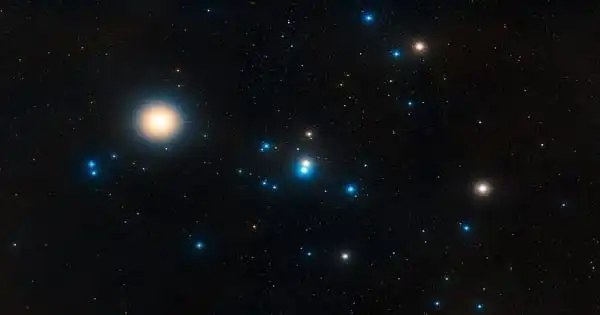A neighboring star’s outburst has led MIT researchers to a new and enigmatic system 3,000 light years away. A new “black widow binary,” or quickly spinning neutron star, or pulsar, appears to be circling and slowly consuming a smaller partner star, as its spider namesake does to its spouse.
There are around two dozen black widow binaries in the Milky Way, according to astronomers. The pulsar and companion star in this new candidate, designated ZTF J1406+1222, have the lowest orbital period yet discovered, circling each other every 62 minutes.
The system is unusual in that it appears to have a third, distant star orbiting the two inner stars every 10,000 years. The possibility of a triple black widow system raises issues about how it could have developed.
The MIT team suggests the following origin scenario based on their findings: The triple system, like most black widow binaries, is thought to have formed from a dense cluster of ancient stars known as a globular cluster.
This cluster may have drifted into the Milky Way’s core, where the gravity of the central black hole was enough to pull it apart while leaving the triple black widow intact.
“It’s a complicated birth scenario,” says Kevin Burdge, a Pappalardo Postdoctoral Fellow in MIT’s Department of Physics. “This system has probably been floating around in the Milky Way for longer than the sun has been around.”
Burdge is the lead author of a Nature paper detailing the team’s discovery. To discover the triple system, the researchers used a novel method. While most black widow binaries are discovered using gamma and X-ray radiation emitted by the central pulsar, the researchers discovered ZTF J1406+1222 using visible light, specifically the flashing from the binary’s companion star.
“This system is really unique as far as black widows go, because we found it with visible light, and because of its wide companion, and the fact it came from the galactic center,” Burdge says. “There’s still a lot we don’t understand about it. But we have a new way of looking for these systems in the sky.”
Collaborators from the University of Warwick, Caltech, the University of Washington, McGill University, and the University of Maryland are among the study’s co-authors.
This system is really unique as far as black widows go, because we found it with visible light, and because of its wide companion, and the fact it came from the galactic center. There’s still a lot we don’t understand about it. But we have a new way of looking for these systems in the sky.
Kevin Burdge
Day and night
Pulsars are rapidly spinning neutron stars that are the collapsed cores of huge stars that power black widow binaries. Pulsars have a dizzying rotating cycle, spinning every few milliseconds and generating high-energy gamma and X-ray flashes as a result.
Pulsars normally spin down and perish soon after expending a large amount of energy. A passing star, on the other hand, can give a pulsar new life every now and then. The pulsar’s gravity pulls material away from the star as it approaches, providing additional energy to spin the pulsar back up. The “recycled” pulsar then begins to reradiate energy, stripping the star further and eventually destroying it.
“These systems are called black widows because of how the pulsar sort of consumes the thing that recycled it, just as the spider eats its mate,” Burdge says.
To date, the pulsar’s gamma and X-ray bursts have spotted every black widow pair. Burdge discovered ZTF J1406+1222 for the first time through the companion star’s optical flashing.
Due to the persistent high-energy radiation it receives from the pulsar, the companion star’s day side, which is always facing the pulsar, can be many times hotter than its night side.
“I thought, instead of looking directly for the pulsar, try looking for the star that it’s cooking,” Burdge explains. He reasoned that if astronomers observed a star whose brightness was changing periodically by a huge amount, it would be a strong signal that it was in a binary with a pulsar.
Star motion
Burdge and his colleagues examined optical data collected by the Zwicky Transient Facility, a California-based observatory that captures wide-field photographs of the night sky.
The researchers looked at the brightness of stars to see if any were altering rapidly by a factor of ten or more over the course of an hour or less, which could suggest the presence of a companion star orbiting closely around a pulsar.
The researchers was able to identify the dozen known black widow binaries, proving the accuracy of the new technique. They subsequently noticed a star that varied brightness by a factor of 13 every 62 minutes, indicating that it was most likely part of a new black widow binary, which they named ZTF J1406+1222.
They found the star in observations made by Gaia, a European Space Agency space telescope that retains exact measurements of the position and motion of stars in the sky.
The scientists discovered that the binary was being pursued by another distant star by looking back at decades-old readings of the star from the Sloan Digital Sky Survey. This third star appeared to orbit the inner pair every 10,000 years, according to their estimates.
Surprisingly, the researchers have not directly observed gamma or X-ray radiation from the binary’s pulsar, which is how black widows are usually confirmed. As a result, ZTF J1406+1222 is regarded as a possible black widow binary, which the team aims to confirm with further observations.
“The one thing we know for sure is that we see a star with a day side that’s much hotter than the night side, orbiting around something every 62 minutes,” Burdge says. “Everything seems to point to it being a black widow binary. But there are a few weird things about it, so it’s possible it’s something entirely new.”
The team wants to keep watching the new system and use the optical approach to illuminate more neutron stars and black widows in the sky. The National Science Foundation helped fund some of this research.
















